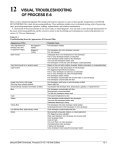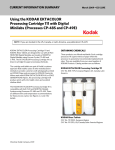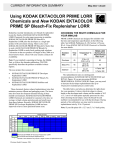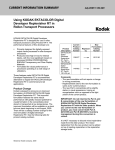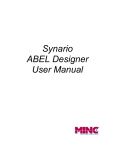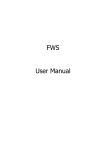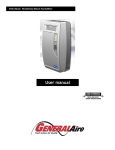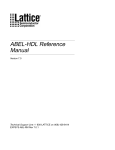Download Kodak FC2 User's Manual
Transcript
CURRENT INFORMATION SUMMARY May 2005 • CIS-254 Using the KODAK Negative Film Processing Cartridges FC1 and FC2 The KODAK Negative Film Processing Cartridges FC1 and FC2 and KODAK Rinse Tablets are designed for use in FUJI FP363SC and FP563SC Film Processors using process cycle CN-16S. The FC1 and FC2 cartridges are drop-in cartridges that provide convenience and ease of use. The FC1 cartridge will process 200 rolls of 135-24 film; the FC2 cartridge will process 1000 rolls of 135-24 film. The cartridges and tablets are part of Kodak’s systems approach that enables users of other manufacturers’ minilabs to provide customers with high-quality film processing in Kodak chemicals. KODAK Negative Film Processing Cartridge FC1 and Shipping Corrugate ©Eastman Kodak Company, 2005 KODAK Negative Film Processing Cartridge FC2 and Shipping Corrugate OBTAINING THE CHEMICALS Preparing Fresh Working Tank Solutions Catalog numbers are as follows: Use the following Kodak chemicals to prepare fresh working tank solutions: Product Min/Mult Order Qty CAT Number KODAK Negative Film Processing Cartridge FC1 2 801 7519 KODAK Negative Film Processing Cartridge FC2 2 867 2701 Developer Tank (N1) Use KODAK Negative Film FC Tank Developer CAT No. 833 9723. Each kit makes 5.2 litres. Two kits are required for the FP363SC processor. Three kits are required for the FP563SC processor. Follow the directions in the following table: FP363SC Processor FP563SC Processor Mix 2 bottles of developer Part A with 2 litres of water in mixing bottle. Add solution to processor developer (N1) tank. Add 4 litres of water to processor developer (N1) tank. Then mix 3 bottles of developer Part A with 2 litres of water in mixing bottle. Add solution to processor developer (N1) tank. 2 Mix 2 bottles of developer Part B with 2 litres of water in mixing bottle. Add solution to processor developer (N1) tank. Mix 3 bottles of developer Part B with 2 litres of water in mixing bottle. Add processor developer (N1) tank. 3 Mix 2 bottles of developer Part C with 2 litres of water in mixing bottle. Add processor developer (N1) tank. Mix 3 bottles of developer Part C with 2 litres of water in mixing bottle. Add processor developer (N1) tank. 4 Position tank level gauge on processor developer (N1) rack. Add water to N1 level mark (about 2.3 litres). Position tank level gauge on processor developer (N1) rack. Add water to N1 level mark (about 2.4 litres). Step KODAK Rinse Tablets* 4 191 3110 KODAK Negative Film FC Tank Developer 1 833 9723 KODAK Negative Film FC Tank Bleach 1 107 2024 KODAK Negative Film FC Tank Fixer 1 813 4421 KODAK Negative Film FC Tank Rinse 3 872 4791 1 *Used in water reservoir on processor SAFE HANDLING OF PHOTOGRAPHIC CHEMICALS Handle all chemicals carefully. When you mix solutions, wear goggles or a face shield, a protective rubber apron, and protective gloves made with neoprene or nitrile rubber. Clean protective clothing after use to remove any chemical residue that can cause contamination. For more information about potential health hazards and safe handling of specific Kodak chemicals, see the label and the Material Safety Data Sheet (MSDS) for the chemical. Consult the MSDS for regional contact information. MSDS copies are available at the Kodak website at www.kodak.com/go/photochemicals. CONVERTING TO THE KODAK NEGATIVE FILM PROCESSING CARTRIDGES No processor adjustments are required to use KODAK Negative Film Processing Cartridges FC1 and FC2. These cartridges are designed to mix and replenish on top of existing solution. Use the same processor settings that you use with your current chemical cartridge. Standard conditions are shown in Figure 1 on page 3. 2 Using the KODAK Negative Film Processing Cartridges FC1 and FC2 • CIS-254 Bleach Tank (N2) Stabilizer/Final Rinse Tanks (N4-1, N4-2, N4-3) Use KODAK Negative Film FC Tank Bleach, CAT No. 107 2024. Each kit makes 3.6 litres of tank bleach solution. One kit is required to prepare the bleach tank in either the FP363SC processor or the FP563SC processor. Add the contents of 1 bottle to the empty bleach (N2) tank. Position the tank level gauge on the bleach (N2) tank rack, and add water to the N2 level mark on the gauge. For faster warm-up, use water close to operating temperature (31 to 41˚C [88 to 106˚F]). Use KODAK Negative Film FC Tank Rinse, CAT No. 872 4791. The kit contains three bottles of concentrate. Each bottle will make 1.9 litres of rinse tank solution. One bottle is required to make a rinse tank solution in each rinse tank of the FP363SC processor or the FP563SC processor (three tanks per machine). Add the contents of one bottle to each empty tank (N4-1, N4-2, N4-3). Position the tank level gauge on the rinse tank rack, and add water to the N4-1, N4-2 or N4-3 level mark on the gauge (depending on which tank is being mixed.). For faster warm up, use water close to operating temperature (31 to 41˚C [88 to 106˚F]). Fixer Tanks (N3-1 & N3-2) Use KODAK Negative Film FC Tank Fixer, CAT No. 813 4421. Each kit makes 3.6 litres of tank fixer solution. One kit is required to prepare each fixer tank in either the FP363SC processor or the FP563SC processor (two tanks per machine). Add the contents of 1 bottle to each empty tank (N3-1 and/or N3-2). Position the tank level gauge on the fix tank rack (N3-1 or N3-2), and add water to the N3-1 or N3-2 level mark on the gauge. For faster warm up, use water close to operating temperature (31 to 41˚C [88 to 106˚F]). Water Reservoir Use KODAK Rinse Tablets, CAT No. 191 3110. Add tablet(s) into the loading port on top of the reservoir before adding water. Use one tablet for every 4 litres of water. Figure 1 CN-16S Process Cycle with KODAK Negative Film Cartridge Chemistry FC2 Cartridge FC1 Cartridge Negative Film Negative Film Rinse Developer Replenisher Replenisher N4-R N1-RB Negative Film Negative Film Negative Film Bleach Developer Fixer Replenisher Replenisher Replenisher N2-R N1-RA N3-R Replenishment Rate mL/135-24 roll 15 (13.5) (mL/M) 5 (4.5) 7.5 (6.75) 30 (27) 1 Developer N1 Bleach N2 Fixer N3-1 Fixer N3-2 3:05 0:50 to 0:70 0:50 to 0:70 0:50 to 0:70 1 Rinse N4-1 Rinse N4-2 Rinse N4-3 0:30 0:20 0:20 Dry Time min:sec Temperature C ( F) _ 0.2 38.0 + _ 0.4) (100.4 + 1 35 - 41 (95 - 106) The N4-2 Rinse is pumped into the N3-2 Fixer Tank to dilute the Fixer Replenisher to specification. Using the KODAK Negative Film Processing Cartridges FC1 and FC2 • CIS-254 3 USING KODAK CONTROL STRIPS, PROCESS C-41, TO MONITOR THE PROCESS Use KODAK Control Strips, Process C-41, to monitor process performance Each time you process a control strip, position it in the same location in the processor. Process a control strip at these times: Plotting Control-Strip Densities Create a control chart by using the KODAK Process Record Form Y-55 or similar graph paper. Your chart should have the same format as the Process CN-16S “Visual Process Control Guide” shown on page 8. Tolerances and Limits for KODAK Control Strips, Process C-41 Aim-Value Adjustment Tolerance Action Limits Control Limits ColorBalance Spread Limit D-min ±0.03 +0.03 +0.05 — LD ±0.04 ±0.06 ±0.08 — HD-LD ±0.03 ±0.07 ±0.09 0.09 D-maxb-Yb ±0.07 +0.10 +0.12 — Measurement • At the beginning of the day or shift, before processing customer work • At the end of the day or shift C-41 9141 Yellow D-max HD 1. Before you begin to use a box of control strips, remove the reference strip from the box, and store it at room temperature. 2. Use a precision densitometer to measure the densities in the center of the Yellow, HD, LD, and D-min patches on the reference strip. Do not move the strip as you make the density readings or you may affect the precision and repeatability of the measurement. Use transmission mode Status M. 3. LD D-min Cutoff Notch KODAK Control Strip, Process C-41 CAT No. 180 3709 4 To obtain the aim densities, apply the correction factors to the densities read in Step 2. The correction factors are found on a sheet packaged with the control strips. Make sure you use the correction factors for Process CN-16S. To obtain the HD-LD aim value, subtract the adjusted LD value form the adjusted HD value. To obtain the D-maxb -Yb aim value, subtract the adjusted blue density of the yellow step from the adjusted blue density of the D-max step. Use the Process CN-16S Reference Aims Worksheet on page 9 to help calculate the aim densities. Note: If you are using an older code of control strip that does not list correction factors for Process CN-16S, apply the Process Factors listed in the following table to the density readings after applying the regular correction factors for Process C-41. Using the KODAK Negative Film Processing Cartridges FC1 and FC2 • CIS-254 Additional Process CN-16S Adjustment Factors for Use with Process C-41 Control Strips Step R G B Yellow 0.00 0.00 0.00 D-max 0.00 0.00 +0.07 HD +0.04 0.00 +0.07 LD 0.00 0.00 0.00 D-min 0.00 0.00 0.00 4. Process a control strip and measure the Yellow, D-maxb-Yb, HD, LD, and D-min patches. 5. Calculate the variations from aim by subtracting the aim densities from your control-strip densities. Plot the variations on your control chart. Plot variations that are higher than the corresponding aim values (+ values) above the aim line. Plot variations that are lower than the aim values (– values) below the aim line. If any of the variations from aim plots beyond the action or control limits, process another control strip. If the second control strip confirms the results of the first strip, determine the cause of the problem. Using the “Visual Process Control Guide” on page 8 provides a good starting place. If the problem is not readily correctable, contact Kodak Service and Support at (866) 352-4367. USING THE “VISUAL PROCESS CONTROL GUIDE” AND KODAK CONTROL STRIPS TO TROUBLESHOOT PROCESS CN-16S If your Process CN-16S control chart indicates an out-ofcontrol plot position, use the “Visual Process Control Guide” as follows to troubleshoot the process and apply corrective action. First check for operational errors: • Make sure the control-strip code matches the reference-strip code. • Calibrate the densitometer. • Re-check the control-strip aims and verify the correction factors. • Verify the problem by processing a second control strip. • Determine if any recent processor maintenance could have caused a problem. • Verify that tank and replenisher solutions were mixed correctly. • Use an accurate thermometer to verify that the developer temperature and other solution temperatures are correct. Match your plots to the “Visual Process Control Guide” to identify the problem: • Match your control plots to the examples given on the “Visual Process Control Guide.” Compare only one plot parameter at a time (D-maxb-Yb, HD-LD, LD, D-min). Note that the pattern of the red, green, and blue plot deviations can be an indicator of different problems. • Write down the problems indicated by each parameter for the plots that are out of control. Consider that you may have more than one problem occurring at the same time. • Consider each potential cause of the out-of-control condition, and verify the operational conditions of the processor. When you have determined the most likely cause(s) of the out-of-control condition, take corrective action to eliminate the cause, and use the prescriptions to eliminate the symptom of the problem. Corrective Action and Prescriptions D-maxb – Yb: This parameter monitors the performance of the bleach solution for retained silver. A bleach solution that is underreplenished or diluted will not efficiently bleach the film, leaving retained silver in higher-density areas. If the D-maxb-Yb indicates a retained-silver problem, confirm it with the following test: 1. Immerse the processed control strip in the bleach tank, and soak it for 7 minutes. 2. Remove the strip, rinse it thoroughly with water for 3 minutes, and dry it. 3. Re-read the strip, re-plot D-maxb-Yb, and compare the new plot to the earlier plot. If the new plot shows a difference of -0.05 density unit or more (lower), it confirms a bleaching problem. If there is no change or less than a 0.05 change, the bleach is not a problem. See the “Visual Process Control Guide” for other possible causes. If the test confirms a bleaching problem, replace the bleach tank solution with fresh solution made from the KODAK Negative Film FC Tank Bleach, as described on page 3. Also check the output of the bleach replenisher pump and calibrate. Be sure that the bleach replenishment rate is set correctly. Using the KODAK Negative Film Processing Cartridges FC1 and FC2 • CIS-254 5 HD-LD (Contrast): LD (speed): This parameter monitors developer activity. Contrast is the primary indicator of developer agitation, oxidation, concentration, or contamination. If the developer tank solution is under-agitated, too dilute, or oxidized, the plots will be low. If the developer tank solution is overconcentrated or contaminated, the plots will be high. If the process is very out of control, i.e., by more than 0.15 density unit over or under aim, replace all of the developer tank solution. If the developer is contaminated, make sure you rinse the tank out thoroughly, and then replace all of the developer tank solution. If the plots are less than 0.15 density unit over or under aim, you can risk a prescription. This parameter monitors developer activity. Speed is the primary indicator of problems with developer time, temperature, and especially replenishment rate. For development time that is too long, temperature that is too high, or overreplenishment, the LD plots will be high. For time that is too short, temperature that is too low, or underreplenishment, the LD plots will be low. Check the developer time and temperature, and adjust them to specification. The developer time should be 3:05 ± 0:05; the temperature should be 38 ± 0.2˚C. If the plots are very out of control, i.e., by more than 0.12 density unit over or under aim, dump and replace all of the developer tank solution. If the plots are less than 0.12 density over or under aim, you can risk a prescription. Prescriptions: • For high HD-LD plots: Overconcentration: Dilute the developer with warm water in an amount equal to 5 percent of the volume in the developer tank. Repeat as necessary until the process is in control. • For low HD-LD plots: Under concentrated (Diluted): Replace developer tank with a tank mix of KODAK Negative Film FC Tank Developer, use mixing instructions on page 2. Under agitation: Call a service representative to fix the agitation pump on the processor. Oxidation: Check for air bubbles in the developer tank, and call a service technician if bubbles are visible. If oxidation is caused by low utilization, see the corrective action in KODAK Publication No. CIS-246, Operating Minilabs at Low Levels of Utilization. This publication is available on the Kodak website at www.kodak.com/go/photochemicals. 6 Prescriptions: • For high LD plots: Overreplenishment: Replace a portion of the developer tank solution (5.2 litres) with one KODAK Negative Film FC Tank Developer Kit. Check the replenishment rate setting. Check the output of the developer replenisher pump and calibrate. Lower the developer replenishment rate by 10 percent or more if necessary. • For low LD plots: Underreplenishment: Replace a portion of the developer tank (5.2 litres) with one KODAK Negative Film FC Tank Developer Kit. Check the replenishment rate setting, and check the pump output of the developer replenisher pump and calibrate. Increase the developer replenishment rate by 10 percent or more if necessary. Using the KODAK Negative Film Processing Cartridges FC1 and FC2 • CIS-254 D-min (Clear Area of Film): This parameter may monitor developer, bleach, or fixer problems. If a developer problem is indicated, see the HD-LD or LD parameter for confirmation and corrective action. If a bleach or fixer problem is indicated, see the corrective action below: Bleach (Stain): Developer carryover into the bleach can form a staining by-product that can elevate D-min, especially the green D-min. This occurs when the bleach is underreplenished or under-aerated. Prescriptions: • Replace the bleach tank solution with KODAK Negative Film FC Tank Bleach. Refer to the directions on page 3. • Check the bleach aeration to make sure it is working properly. • Check the output of the bleach replenishment pump and calibrate. • Check the replenishment rate for bleach, and adjust to the correct rate. MANAGING EMPTY CARTRIDGES In most regions, it should be possible to participate in a local community recycling program. Check with program authorities to determine if these packaging materials are eligible for local recycling. If they are accepted, disassemble the package and place the bottles and corrugated material in your recycling bin. Follow all material preparation instructions from the recycler. See KODAK Publication No. CIS-148, Recycling KODAK Photochemical Containers, for more information on preparing the empty bottles for recycling. CIS-148 and other publications on waste management are available on the Kodak website at www.kodak.com/go/KES. If local recycling is not an option, dispose of the empty bottles and the package with your normal solid waste. SILVER RECOVERY Publications on silver management that include recommendations and descriptions of silver-recovery options are available in the Silver Management section of the Kodak Environmental Services Publications Center at www.kodak.com/go/KES. Fixer (Retained Silver Halide): Retained silver halide is caused by an exhausted fixer solution due to underreplenishment, dilution, or oxidation. This is indicated by a high D-min, especially the red D-min. To confirm retained silver halide, run this test: 1. Immerse the processed control strip in the fixer tank and soak it for 7 minutes. 2. Remove the strip, rinse it thoroughly with water for 3 minutes, and dry it. 3. Re-read the strip and re-plot D-min. Compare the red D-min to the earlier plot. If the new plot shows a difference of at least 0.05 (lower), it confirms a fixer problem. Replace both fixer tanks with KODAK Negative Film FC Tank Fixer. Use directions on page 3. Also, check the output of the fixer replenisher pump and calibrate. Set the fixer replenishment rate to the correct value. If there is no change or less than a 0.05 change, the fixer is not a problem. See the “Visual Process Control Guide” for other possible causes. Using the KODAK Negative Film Processing Cartridges FC1 and FC2 • CIS-254 7 Figure 2 Process CN-16S Visual Process Control Guide .25 Relative Height of RGB arrows is an indicator of control-strip performance leading to the cause indicated in text box .20 D-maxB - YB (+ 0.10 & 0.12) Bleach Activity - retained silver .15 Retained Silver .10 + Bleach is dilute or underreplenished .05 +0 .05 .10 .15 .20 .25 .25 HD-LD (+/- 0.07 & 0.09) Developer Activity - concentration - contamination - oxidation - agitation .20 .15 + Contamination, if sudden + Possibly frozen reference .10 .05 + Over concentrated, if trend .05 .10 - Underconcentrated, if trend +0 - - Oxidized, if trend - Agitation, if rapid loss .15 .20 .25 LD (+/- 0.06 & 0.08) Developer Activity - time/temp - replenishment D-min (+ 0.03 & 0.05) .15 .10 +0 - - Developer temperature too low or time too short .05 .10 .15 .05 +0 - overconcentration .05 Developer + Developer temperature too high or dev time too long .05 + Weak Fixer, Developer contamination or light fog +Developer Replenishment too high (trend) - Developer Replenishment too low (trend) + Developer overreplenished or overconcentrated Leuco Cyan Dye Bleach very dilute or Fixer underreplenished (trend) + Bleach stain from too much Developer carry-over, no aeration or underreplenishment - overreplenishment Bleach - stain DATES Fixer Activity 8 - retained silver halide PROCESS: F002_1271EC MACHINE: EASTMAN KODAK COMPANY, Rochester, NY 14650 Using the KODAK Negative Film Processing Cartridges FC1 and FC2 • CIS-254 Process CN-16S Reference Aims Worksheet Date: Code: Red Green Blue D-maxb Density Readings Control Strip Correction Factor Corrected D-max Yellowb Density Reading Control Strip Correction Factor Corrected Yellowb AIM D-maxb-Yb HD Density Readings Control Strip Correction Factors Corrected HD LD Density Readings Control Strip Correction Factors AIM LD AIM HD-LD D-min Density Readings Control Strip Correction Factors AIM D-min Using the KODAK Negative Film Processing Cartridges FC1 and FC2 • CIS-254 9 Note: The contents of this publication are subject to change. To be sure you have the most up-to-date publication, check www.kodak.com/go/photochemicals; select Technical Information to find Current Information Summaries. Digital & Film Imaging Systems EASTMAN KODAK COMPANY • ROCHESTER, NY 14650 Using KODAK Negative Film Processing Cartridges FC1 and FC2 KODAK Publication No. CIS-254 Kodak is a trademark. Minor Revision 5-05










